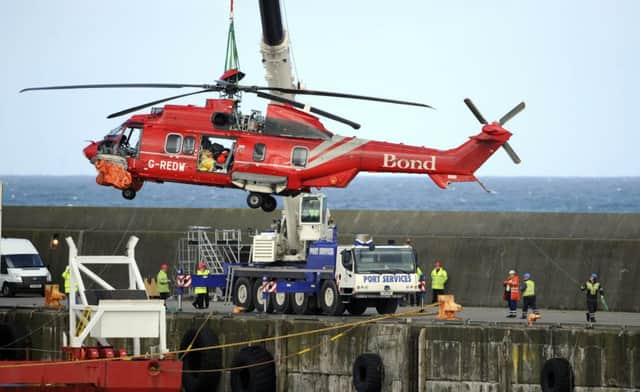Safety briefing review call for helicopter flights


Air crash investigators have issued a special bulletin on the tragedy to highlight safety concerns relating to the briefings which are given to oil workers about the way the potentially life saving equipment works.
The emergency breathing system are provided to passenger on the majority of offshore flights. But there are three separate system in use.
Three of the four victims drowned in the disaster.
Advertisement
Hide AdAdvertisement
Hide AdAccording to the report research has shown that in some 60 per cent of all helicopter ditchings and crashes the helicopter has inverted or sunk either immediately or after short delay.
It continues: “A capsize often occurred before evacuation of the occupants could be completed. Emergency breathing systems (EBS) were developed to allow helicopter occupants to breathe underwater for a short period of time.
“The EBS can bridge the gap between the maximum breath-hold time of an occupant and the time required to complete an underwater escape, thereby increasing the chances of survival. EBS were introduced in UK North Sea offshore helicopter operations as a voluntary industry standard - at present there is no regulatory requirement for such equipment.”
Three different types of systems are currently in use - a compressed air system with a mouthpiece, a rebreather system, and a hybrid system consisting of a rebreather system with a cylinder of compressed air.
The report continues: “The pre-flight safety briefing material has been reviewed by the AAIB as part of its ongoing investigation. This has identified that the briefing material does not include fully representative information about the EBS.
“It does not highlight that the EBS provided may be a hybrid rebreather containing an air supply which is discharged automatically into the rebreather bag, or that the system can be used even if the wearer has not taken a breath before becoming submerged.”
The report wars: “Incomplete information in the pre flight safety briefing material may give passengers the false impression that hybrid rebreathers,such as the widely used LAP system, are only of benefit if the user has taken breath prior to becoming submerged.
“Knowledge that hybrid rebreathers contain their own supply of air may therefore influence a passenger’s decision on whether or not to use the EBS in an emergency situation.”
Advertisement
Hide AdAdvertisement
Hide AdIt continues: “The AAIB has approached the main helicopter o[operators flying in support of the UK oil and gas industry, whose passengers are equipped with a hybrid EBS.
“Whilst operation of the hybrid EBS should be covered in initial and recurrent training, it is not explicitly described in the pre-flight safety briefing.
“The operators have undertaken to amend their pre-flight briefing material to include information that the hybrid system contains its own air supply which is discharged automatically, making the system usable even if the wearer has not taken a breath before becoming submerged.”
The four oil workers were killed when the CHC-operated Super Puma AS332L2 helicopter crashed on its approach to Shetland’s Sumburgh airport on 23 August last year. Those who died were Sarah Darnley, 45, from Elgin, Gary McCrossan, 59, from Inverness, Duncan Munro, 46, from Bishop Auckland, and George Allison, 57, from Winchester.
The LAP (Lifejacket Airpocket Plus) system is a hybrid system comprising a combined lifejacket and hybrid rebreather. According to the report, this particular model of EBS has been widely adopted for use by
operators of UK North Sea offshore helicopter flights and is “routinely” provided to passengers.